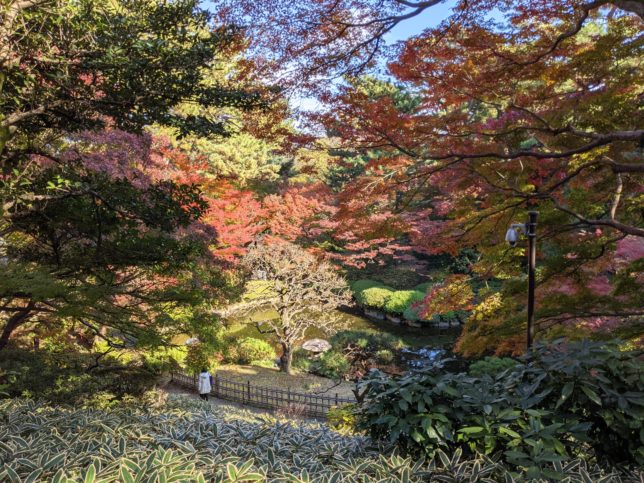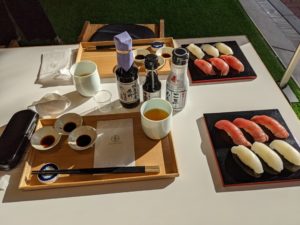Sunday, December 6, 2020.
It being a beautiful late fall day, my wife wanted to go out and see and enjoy some local kōyō, known in English as autumn foliage. We didn’t want to leave the city, so we decided to head towards some parks in the Shirokanedai area or Minato-ku. Our first stop was Ikedayama Koen, a small park with a nice traditional Japanese garden built around a pond on the site of a secondary residence for the Ikeda clan, the daimyo family from modern day Okayama. From there it was a short walk over to Teien Park and art museum for some more red, orange and yellow viewing, again the Japanese garden built around a pond filled with brightly colored koi. As we were leaving and wondering what to do next, we decided to call our friend Kate who lives just ten minutes or so away on foot. As it happened, she was in the almost next-door park walking a white Labrador named Masa she has been helping train to be a companion dog for kids in the hospital. After meeting and playing with Masa we started walking along while talking about what to eat for lunch. Whatever it would be, the restaurant needed to accept dogs, or at least have a place to tie Masa up within view of our seats. When we looked across the street we saw a place that just might work; a pop-up restaurant event at MuSuBu, a spinoff from nearby Happō-en (Happō-en is a mix of restaurants and wedding hall, all set around a beautiful garden dating from the early Edo period: https://www.happo-en.com/). The poster in front said something about sushi, sake, Fukushima, and ¥1,000, which was enough to induce us to cross the street, tie up Masa, and go inside.
After meeting and playing with Masa we started walking along while talking about what to eat for lunch. Whatever it would be, the restaurant needed to accept dogs, or at least have a place to tie Masa up within view of our seats. When we looked across the street we saw a place that just might work; a pop-up restaurant event at MuSuBu, a spinoff from nearby Happō-en (Happō-en is a mix of restaurants and wedding hall, all set around a beautiful garden dating from the early Edo period: https://www.happo-en.com/). The poster in front said something about sushi, sake, Fukushima, and ¥1,000, which was enough to induce us to cross the street, tie up Masa, and go inside.
Inside the main door was a very large, newly made barrel for making shoyu, as well as a table serving tastes of sake from Fukushima. There was also a sign saying the sushi tasting was ¥1,000 per person, and that for an extra ¥1,000 per group you would receive a set of three different bottles of shoyu. The basic tasting also included a bowl of vegetable stew in chicken dashi, and ice cream. We ordered, then sat down at a table next to a sliding glass door as Kate moved Masa over to the door. Luckily there was fake grass/astroturf on the floor, perfect for a dog to lie on.
We were given a small cloth bag with three different bottles of shoyu and then served plates with three pieces each of very good maguro and ika sashimi, with a three section dish for the different shōyus to be dipped in. The first shoyu, a moromi based aged for one year made by Maruisyoyu from Nagano, was very light, almost sweet, something we all described as “easy to drink,” if we drank shoyu. The third was a two-year old moromi type made by Neda Shōyu from Fukushima which had the strong, salty flavor of typical Edo shoyu. The second one fell in the middle (the bottle went home with Kate). We washed our sashimi down with a glass of the sake. After that we took turns going upstairs to eat the stew which shiitake and nameko mushrooms, satō imo, and kōyadōfu, a very autumnal mix of ingredients. While my wife and I were eating a woman from Fukushima NHK Television asked if she could interview us, which we agreed to. She was mostly interested in my, the non-Japanese person’s, impressions of the food and event, as well as of Fukushima. Unfortunately I had not yet had a chance to really look into what the event was all about, instead mainly spending my time there chatting with my wife and friend and playing with Masa. Oh, as for the ice cream, it was plain vanilla, served with the three different shōyus to pour over it. This time the middle one tasted best.
 During all of this the staff of Happō-en was extremely friendly and helpful. Just fantastic hospitality all around. And they were even tolerant of a big dog laying in the doorway, perhaps because he seemed to be attracting passers by to come on in. We learned that the space had been rented by Happō-en as a place to hold Olympics related events. With the Olympics delayed for at least one year and Happō-en wanting to maintain control of it, they are using the space to hold various events, including things related to food, music and other culture.
During all of this the staff of Happō-en was extremely friendly and helpful. Just fantastic hospitality all around. And they were even tolerant of a big dog laying in the doorway, perhaps because he seemed to be attracting passers by to come on in. We learned that the space had been rented by Happō-en as a place to hold Olympics related events. With the Olympics delayed for at least one year and Happō-en wanting to maintain control of it, they are using the space to hold various events, including things related to food, music and other culture.
After returning home and doing some research I learned the following: The event’s main purposes were to promote the shoyu and the sake while and their connections to the big cedar barrel in the entry. The barrel, and accompanying video of how it was made, were part of something called the Kioke Project, an initiative to preserve the craft of traditional barrel making (https://kinbue.jp/en_profile). Apparently, there are only 60 people left in Japan who can do this, something extremely important for making not just shoyu but also miso and sake (I am not sure if people that make and repair oak barrels for aging whisky in are included). It’s good to see people making an effort to keep traditional—and still necessary—crafts alive.